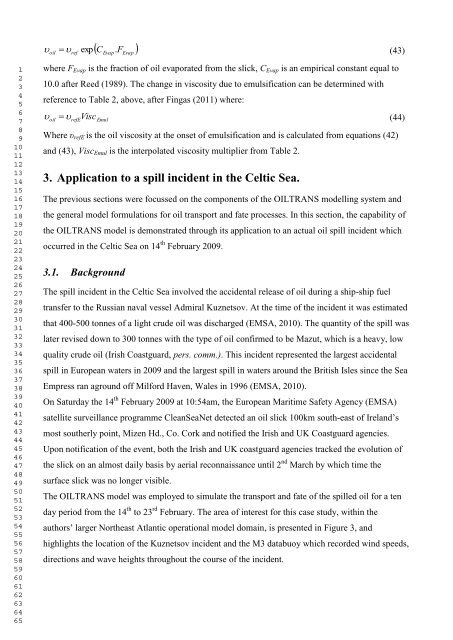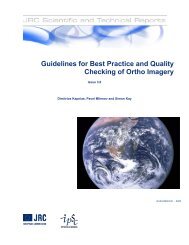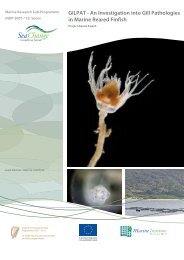The oil spill model OILTRANS and its application to the Celtic Sea ...
The oil spill model OILTRANS and its application to the Celtic Sea ...
The oil spill model OILTRANS and its application to the Celtic Sea ...
Create successful ePaper yourself
Turn your PDF publications into a flip-book with our unique Google optimized e-Paper software.
1234567891011121314151617181920212223242526272829303132333435363738394041424344454647484950515253545556575859606162636465<strong>oil</strong>refEvapEvap exp C . F(43)where F Evap is <strong>the</strong> fraction of <strong>oil</strong> evaporated from <strong>the</strong> slick, C Evap is an empirical constant equal <strong>to</strong>10.0 after Reed (1989). <strong>The</strong> change in viscosity due <strong>to</strong> emulsification can be determined withreference <strong>to</strong> Table 2, above, after Fingas (2011) where: Visc(44)<strong>oil</strong>refEEmulWhere υ refE is <strong>the</strong> <strong>oil</strong> viscosity at <strong>the</strong> onset of emulsification <strong>and</strong> is calculated from equations (42)<strong>and</strong> (43), Visc Emul is <strong>the</strong> interpolated viscosity multiplier from Table 2.3. Application <strong>to</strong> a <strong>spill</strong> incident in <strong>the</strong> <strong>Celtic</strong> <strong>Sea</strong>.<strong>The</strong> previous sections were focussed on <strong>the</strong> components of <strong>the</strong> <strong>OILTRANS</strong> <strong>model</strong>ling system <strong>and</strong><strong>the</strong> general <strong>model</strong> formulations for <strong>oil</strong> transport <strong>and</strong> fate processes. In this section, <strong>the</strong> capability of<strong>the</strong> <strong>OILTRANS</strong> <strong>model</strong> is demonstrated through <strong>its</strong> <strong>application</strong> <strong>to</strong> an actual <strong>oil</strong> <strong>spill</strong> incident whichoccurred in <strong>the</strong> <strong>Celtic</strong> <strong>Sea</strong> on 14 th February 2009.3.1. Background<strong>The</strong> <strong>spill</strong> incident in <strong>the</strong> <strong>Celtic</strong> <strong>Sea</strong> involved <strong>the</strong> accidental release of <strong>oil</strong> during a ship-ship fueltransfer <strong>to</strong> <strong>the</strong> Russian naval vessel Admiral Kuznetsov. At <strong>the</strong> time of <strong>the</strong> incident it was estimatedthat 400-500 <strong>to</strong>nnes of a light crude <strong>oil</strong> was discharged (EMSA, 2010). <strong>The</strong> quantity of <strong>the</strong> <strong>spill</strong> waslater revised down <strong>to</strong> 300 <strong>to</strong>nnes with <strong>the</strong> type of <strong>oil</strong> confirmed <strong>to</strong> be Mazut, which is a heavy, lowquality crude <strong>oil</strong> (Irish Coastguard, pers. comm.). This incident represented <strong>the</strong> largest accidental<strong>spill</strong> in European waters in 2009 <strong>and</strong> <strong>the</strong> largest <strong>spill</strong> in waters around <strong>the</strong> British Isles since <strong>the</strong> <strong>Sea</strong>Empress ran aground off Milford Haven, Wales in 1996 (EMSA, 2010).On Saturday <strong>the</strong> 14 th February 2009 at 10:54am, <strong>the</strong> European Maritime Safety Agency (EMSA)satellite surveillance programme Clean<strong>Sea</strong>Net detected an <strong>oil</strong> slick 100km south-east of Irel<strong>and</strong>‟smost sou<strong>the</strong>rly point, Mizen Hd., Co. Cork <strong>and</strong> notified <strong>the</strong> Irish <strong>and</strong> UK Coastguard agencies.Upon notification of <strong>the</strong> event, both <strong>the</strong> Irish <strong>and</strong> UK coastguard agencies tracked <strong>the</strong> evolution of<strong>the</strong> slick on an almost daily basis by aerial reconnaissance until 2 nd March by which time <strong>the</strong>surface slick was no longer visible.<strong>The</strong> <strong>OILTRANS</strong> <strong>model</strong> was employed <strong>to</strong> simulate <strong>the</strong> transport <strong>and</strong> fate of <strong>the</strong> <strong>spill</strong>ed <strong>oil</strong> for a tenday period from <strong>the</strong> 14 th <strong>to</strong> 23 rd February. <strong>The</strong> area of interest for this case study, within <strong>the</strong>authors‟ larger Nor<strong>the</strong>ast Atlantic operational <strong>model</strong> domain, is presented in Figure 3, <strong>and</strong>highlights <strong>the</strong> location of <strong>the</strong> Kuznetsov incident <strong>and</strong> <strong>the</strong> M3 databuoy which recorded wind speeds,directions <strong>and</strong> wave heights throughout <strong>the</strong> course of <strong>the</strong> incident.
















